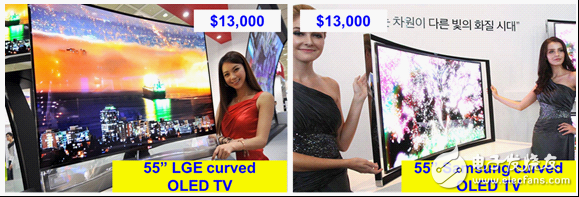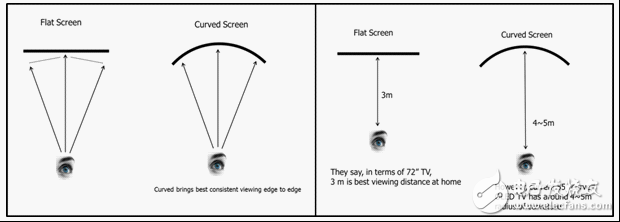In April 2013, South Korea ’s LG Electronics launched its first curved OLED TV. The effect emphasized by LG Electronics is a 55-inch screen, curved shape and WRGB four-color pixel technology, which can make the 3D image effect more realistic. . In fact, LG Electronics and Samsung Electronics both exhibited curved OLED TV prototypes at the US CES show in January 2013, but the release date was not announced at the time. Four months later, we saw the advent of the first curved OLED TV, but its manufacturing technology was still very immature. Samsung followed suit, and in July Samsung finally launched a 55 â€curved OLED TV. At this point, the two major Korean panel makers and TV makers began to push OLED TVs into a new era of not flat but curved surfaces.
Of course, as shown in the figure below, due to the high cost of manufacturing and materials, when they were first launched, they were locked in a very niche ultra-high-end market with high pricing exceeding US $ 10,000. However, recently, Samsung seems to have made breakthroughs in production efficiency and material costs, and Samsung Electronics has decided to reduce its cutting-edge flexible screen OLED TV products by 34% from the previous 15 million won to 9.9 million won, Samsung said This move will attract more users while guiding the growth of the OLED TV market. .
Figure 1. The 55 â€Curved OLED TV of LG Electronics and Samsung

Data source: The DisplaySearch Market Tracker
From the point of view of NPD DisplaySearch, in which ways is curved TV better than flat TV? Compared to other TV technologies and specifications, curved TVs do not have a particularly prominent advantage. However, NPD DisplaySearch believes that from the perspective of design and some other factors, its curved shape has many attractive sales hotspots:
· So far, most TVs are flat, so the curved screen shape is easily distinguishable in style. In fact, in the current flat-screen TVs with highly homogenous appearance design, curved surface is very easy to form brand differentiation.
· Curved OLED TV can provide the best viewing effect from edge to edge. As shown by the so-called curved surface effect in the following drawings, the curved design surrounded by the entire screen toward the viewer can provide a wider viewing angle and a wide panoramic image effect.
· For curved TVs, it also reduces the distortion of off-axis viewing when viewed at close range.
· Curved TVs will lengthen the viewing distance of TV viewers, and this will prompt consumers to buy larger-size TVs, which will virtually increase the demand area and average size of TVs.
Figure 2. Surface effect

Data source: The DisplaySearch Market Tracker
Of course, the curved surface is not only formed on the OLED. NPD DisplaySearch believes that with the introduction of ultra-thin glass substrates, the LCD technology can also achieve the effect of a curved surface, but because LCD TVs use backlight components and The structure of the two glass substrates needs to overcome many technical challenges when manufacturing curved LCD TVs, including:
· It is difficult to achieve uniformity of brightness and high luminous efficiency on a curved backlight panel.
· For curved LCD panels, the image quality at the edges will be distorted due to the mismatch between the pixels of the TFT and the color filter, causing viewing angle problems.
· The problem of low reliability has appeared in the impact test. Because the bending force will be concentrated in the tight gap sealed by the liquid crystal, and the curved backlight assembly may not be able to resist the impact well.
· Due to the curved shape of the panel, the attachment of polarizers and FPCB (flexible printed circuit board) printing, etc., require the development of new engineering technologies.
However, because OLED is a self-luminous panel, it does not require additional backlight components as a light source. OLED can also use a single glass substrate with metal layer packaging technology. The design and structural advantages of OLED can better form a curved shape. However, the curved OLED manufacturing process also faces many challenges.
The first is that the bending process technology of OLED TVs is still immature. NPD DisplaySearch believes that, as shown in Figure 3, there are two possible processes for manufacturing curved OLED TVs:
· A curved surface is formed during the OLED packaging process
· Form the curved surface after completing the OLED panel manufacturing process
Figure 3. Two manufacturing methods for curved OLED TVs

Data source: NPD DisplaySearch AMOLED Process Roadmap Report
We believe that Samsung and LG should use different manufacturing processes, because their OLED technology is different, Samsung uses RGB OLED, and LG Display uses White OLED plus color filters. However, the manufacturing process of OLED is already quite complicated and inconsistent, and the curved surface may make it more complicated, which can not reduce the cost by standardization. In addition, there is a challenge that in order to improve the strength under the impact of strength, the OLED frame must be harder and thicker than the LCD TV. Moreover, when the OLED material meets the hot gas after heating and evaporation, it will reduce the light efficiency and service life to a certain extent. During the bending process, high temperature and pressure will also be used, and the production of modules as OLED polarizer attachments will also cause problems. These are the major challenges for curved OLED TVs.
The TV manufacturing technology using LCD is already comparable, and the growth of the TV market tends to be conservative. Therefore, most manufacturers do not want to continue to increase their LCD manufacturing capacity. However, with the continuous improvement of technology and improvement of performance, NPD DisplaySearch believes that with the listing of curved OLED TVs, the focus of TV manufacturers will gradually shift from flat to curved. Although high-resolution products are the mainstream of current LCD manufacturing trends, current high-resolution panels such as 4Kx2K have exceeded the existing limits of TV signal broadcasting, and consumers may not be able to feel the obvious difference. But in order to compete with high-performance LCD TVs, curved OLED TVs are being promoted as a new trend, and its emphasis is on having a good marketing point. If successful, curved TVs will lead a new trend in the display market.
Control impedance PCB
Many customers asked us what information we need for impedence control PCB.Here,there are two types for PCB manufacturer,a is single impedance ,just one trace ,two holes .and b is differential impedance,it always go with 1 pair (two trace with same width and space). For single impedance,you just tell us the trace width one which layer and what value you require .For differential impedance,trace width/space,layers and value. Our experience engineers will calculate following your instruction with Polar software.We may change trace width/space or stackup ,but please do not worry, if any changes,we will send you to approve before proceeding. Generally,the tolerance is 10%,and more accurate is 8% .All impedance boards ,we will test here and report.
Impedance Control Board,Impedance Controlled PCB,Gold Fingers PCB,Impedance Control PCB
Storm Circuit Technology Ltd , https://www.stormpcb.com